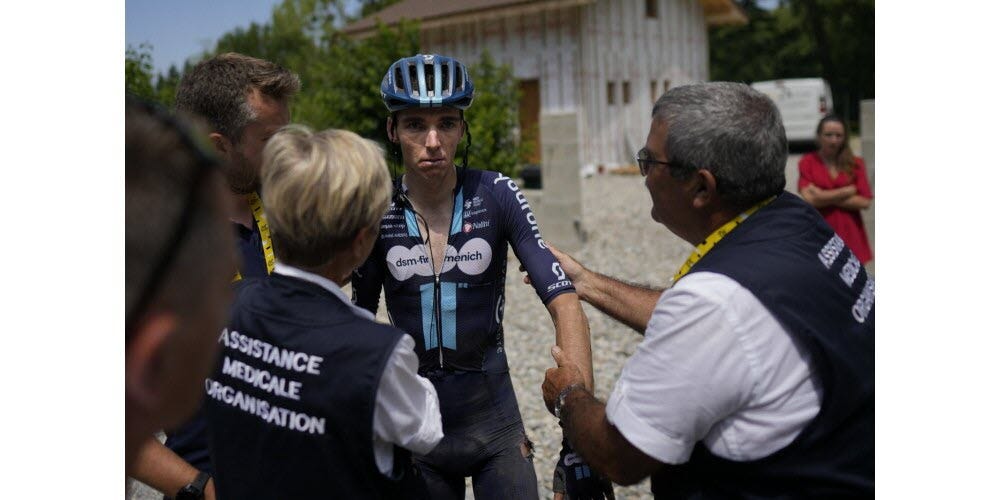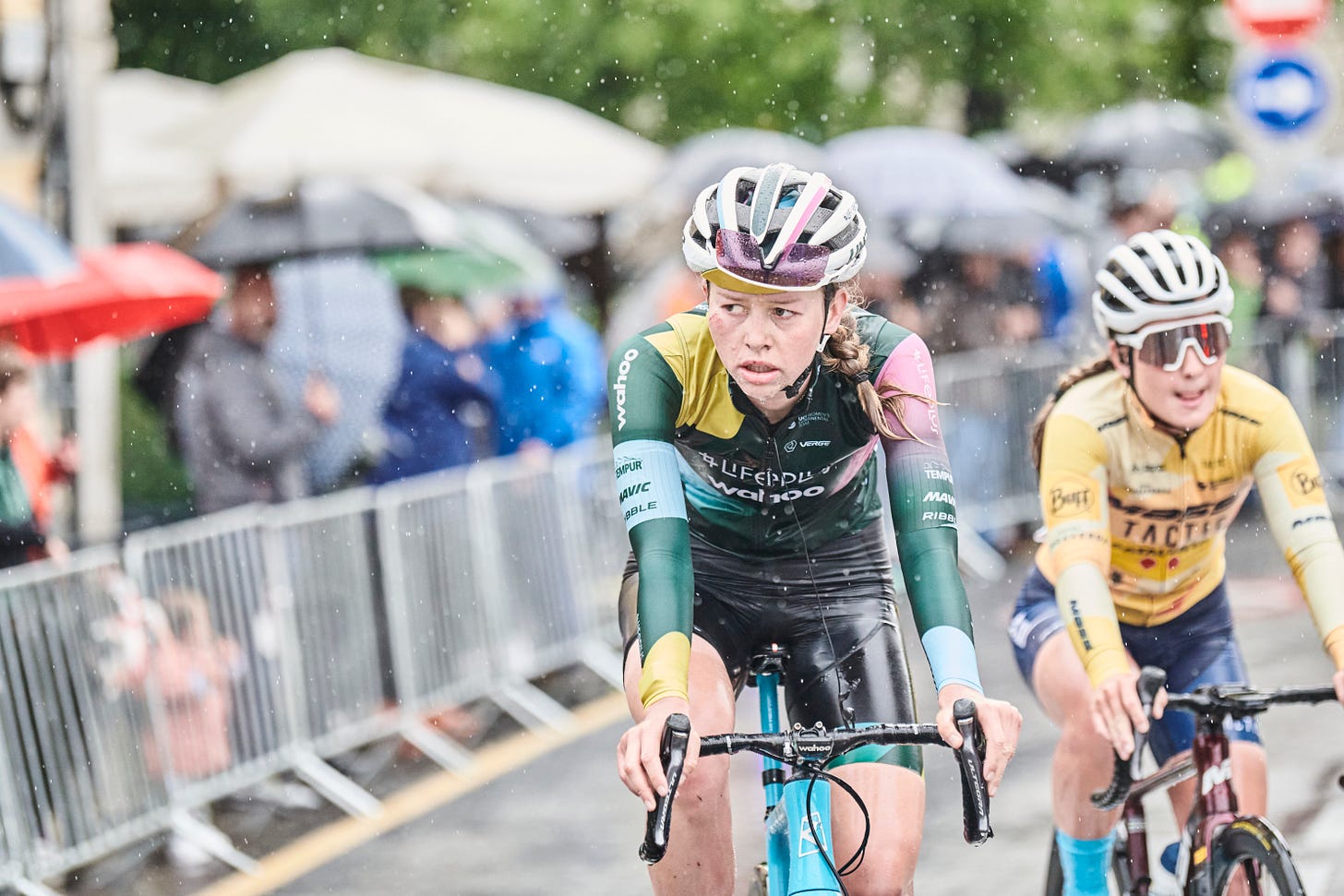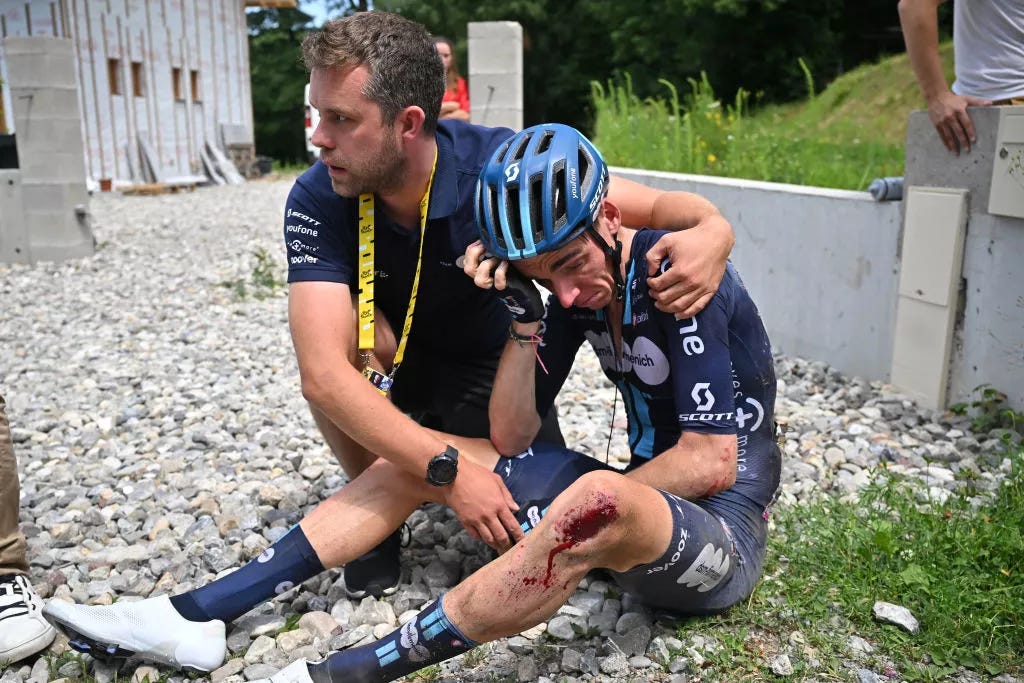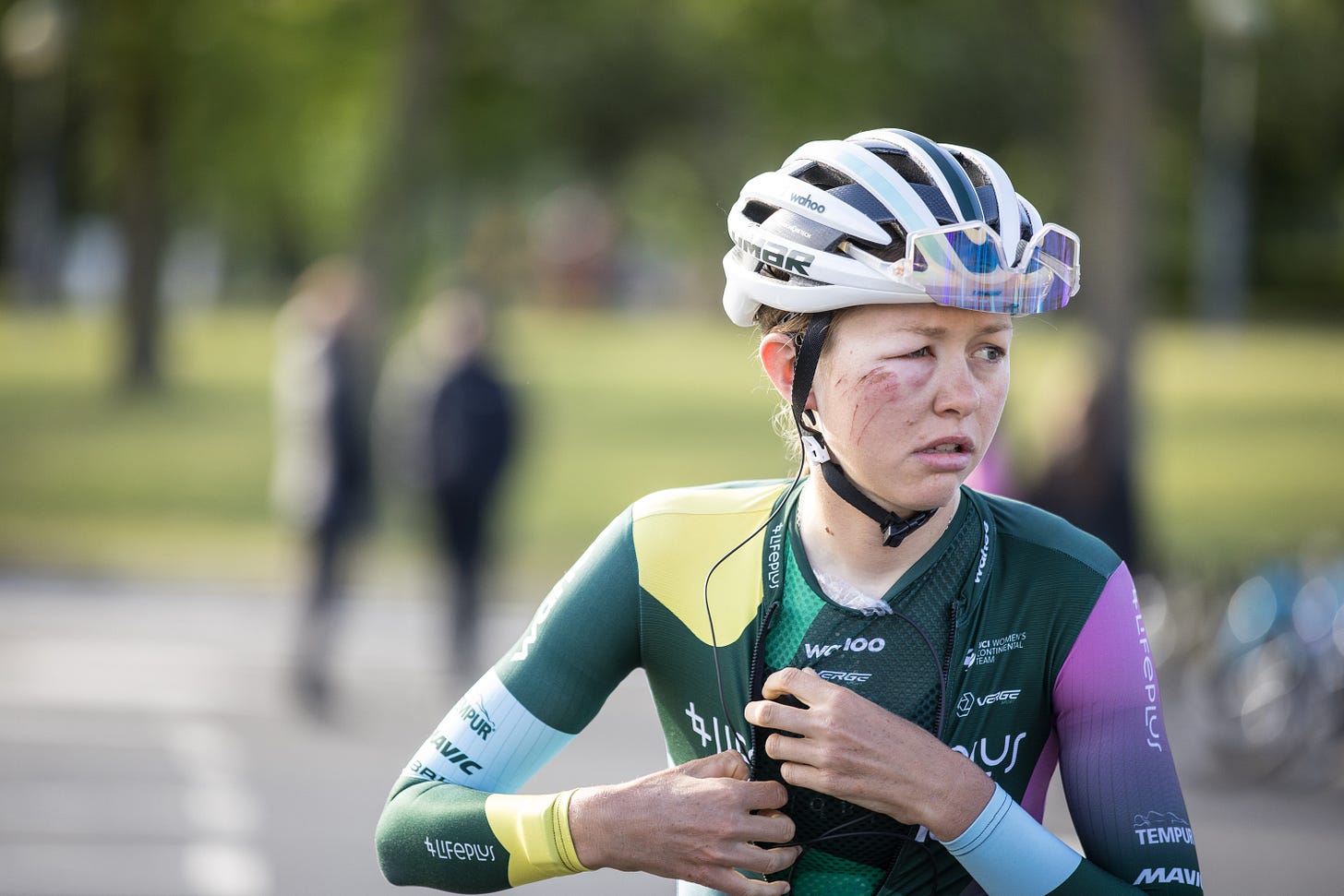After watching stage 14 of the Tour de France and following the media updates in the hours after, I was particularly struck by the way that riders who crashed were treated by their teams. This sentence sounds quite negative and sinister, but it is really quite the contrary.
Three riders from three different teams - Romain Bardet of dsm-firmenich (note I have followed their highly controversial choice of using lower-case letters), James Shaw of EF Education-EasyPost and Dani Martinez of INEOS Grenadiers were all taken out of the Tour de France by their teams after displaying concussion symptoms. In the cases of Bardet and Shaw, who both went down in the same incident, their team staff in the following convoy made the quick decision to pull them from the race on the roadside. For Martinez, it was through further medical assessment after the stage where his concussion symptoms were detected and he was deemed unable to start the next day.
Photo credit: Photo Sipa/Thibault Camus
This is currently a topic of particular relevance and interest for me, as I am still suffering from the effects of a concussion sustained in a crash at the Itzulia Women stage race over two months ago. I am not writing this to criticise the support I received or the management of my crash, but to rather reflect on what I’ve subsequently seen and realised about handling concussions.
Upon impact with the road, I immediately felt the heavy smack reverberate through my head and could sense that I’d also given my upper cheek a decent blow. I was dazed, I was not coherent and the world around me had suddenly slowed to half-speed, but with my team mate readying my bike and the race moving on without me, I gingerly remounted and was coaxed along gently with a draft behind my team mate. We gradually got back into a groove and after motor-pacing from the team car to the base of the final 5km climb, I rode up like a woman possessed, trying to pick off as many riders as possible. I then descended the wet and technical finishing downhill like it was my maiden voyage on a road bike. My focus was narrowed to only thinking about limiting my losses and clawing back any time or placing that I could, but once I crossed the finish line, I crumbled into an irrational emotional state and the dull throb in my head slowly came more into my consciousness.
Photo credit: Naike Foto Sport
I’m no psychologist and am not about to find any scholarly sources, but this is my take on it.
As an athlete, especially one in competition, our inner voice is seemingly wired to keep spurring us on no matter the circumstances. When our bodies come under threat, our most basic response mechanism is to find our bike again and get back on it. Our drive and vision is skewed as we become focussed on what we think is most important in that moment - finishing what we set off to do in the first instance. Finishing that race.
This is why concussion plans and procedures are so important when it comes to the immediate safety and longer term well-being of riders, because more often than not, riders are simply not in the right state of mind to make a rational decision about whether they should be continuing on. Their body is having a stress response after being unexpectedly catapulted out of a high stimulus racing situation and into a slow-moving void. Without somebody stepping in, they’ll do whatever it takes to return to that fast-paced environment and get back on track towards their pending objective. A broken bone would put a stop to this fairly quickly, especially as adrenaline wears off, but ‘hidden’ injuries like concussion can remain undetected and cause serious risk to the rider if the immediate situation is not managed by a second, clear-thinking party.
Going back to the Tour de France, Romain Bardet was immediately joined by the race doctor and his director, Matt Winston, after his crash. Winston recollected that Bardet was “a little dazed and when he stood up I didn’t feel like he was directly jumping back onto his feet as quickly as he should.”
Despite this, Bardet desperately wanted to continue what was his home event and the biggest race of the year, and would have almost certainly attempted to battle on if it wasn’t for those looking out for him.
While the race rapidly progressed further into the distance and grappling with the prospect of losing their best GC & stage hunting contender, Winston admitted that it was a difficult decision to remove Bardet from the race. He affirmed his position by commenting that they have to make sure they are taking the “smart steps in these moments” and that he doesn’t want to risk the long term health of any guy who rides for the team.
“The thing with concussion is that we have to make sure we protect the athlete now”.
Photo credit: Getty Sport Images
Pain and discomfort are heralded as things to push through and overcome, while letting them get the better of you is the ultimate sin. One does not have to look far to see a recent example of this, where Lotto Dtsny’s Caleb Ewan was slandered by his team’s general manager who questioned his mental toughness after he abandoned stage 13. In the context of concussion however, this regurgitated rhetoric is outdated, ill informed and frankly unsafe. The stance taken by the teams at this year’s Tour de France is almost a mini triumph for the awareness of concussion in cycling, because their actions demonstrate how serious the subject is and should be taken.
Not much was said from INEOS Grenadiers & EF Education-EasyPost on the specific protocols that they went through when assessing their own respective riders, but the sentiment remains the same. All three teams acknowledged the consequential risk that concussion poses through removing their riders from the race, setting a powerful example for any level of cyclist who might find themselves in a similar situation. Taking a precautionary approach rather than risking future repercussions is the key lesson for all cyclists, regardless of whether they have access to team doctors or specific concussion procedures. By minimising the stress placed on the body after a head knock (or head discomfort) through immediately ceasing activity and then adhering to basic concussion advice, the chances of a quick and smooth recovery period are increased.
For me in my very muddled state, there was nobody at the crash scene preventing me from completing the final 25km of the stage, but seeing the strong concussion measures at Tour de France may have been the insight that I needed to take things into my own hands. Perhaps I would have made the tough but ultimately correct decision of not attempting to start stage 2 the next day. I could have also focussed on concussion recovery protocols rather than continually attempting to ride my bike in the days that followed. I should have accepted that I would not be starting the next tour (Vuelta a Burgos Feminas) in 5 days time and headed straight home, content in the knowledge that a good early recovery phase would lead to a more favourable result in the long term. Instead, I spent a week in denial trying to brush off my symptoms and expecting to wake up each day feeling normal again. All of this combined has almost certainly contributed to my absence at a tour of actual importance, while my concussion symptoms are still very much present.
Photo credit: Naike Foto Sport
Previously, there has almost been this feeling of “oh, that’s all” when a rider is diagnosed with concussion, having escaped any ‘real’ injuries and presumably coming away from a crash largely unscathed. I think that there has also been an old-fashioned perception of a rider being overly dramatic or soft when they’ve ‘only’ got a concussion but aren’t continuing to race. Thanks to continued research, increased information and a greater awareness of the injury, the tide is changing and concussion is being steadily accepted as a far more serious matter. Observing how responsibly concussions are now being dealt with at the pinnacle of cycling is testament to this change, and having this approach trickle through the sport can only be a good thing in enabling concussions to receive the caution that they deserve.
How much a person can suffer is held up as a key performance indicator, and those riding with a jersey held together by two threads and their bum cheeks on show are immortalised as heroes. Let’s be real, we’ve all seen those memes comparing cyclists to limping soccer players. Concussion doesn’t appear epic though, and won’t make you look like a hero either - in fact, staying off the bike is not that dissimilar to walking off the footy pitch. Concussion is however an invisible injury that can have a far greater impact than a glute graze, and the actions taken during and after stage 14 of the Tour de France highlight the significant progression made in the recognition and treatment of this injury. After all, the UK Government concussion guidelines do say, “if in doubt, sit them out”.
Information and quotes sourced from:
https://www.cyclingweekly.com/racing/its-not-worth-risking-his-long-term-health-dsm-firmenich-withdraw-concussed-romain-bardet-from-tour-de-france
https://cyclinguptodate.com/cycling/daniel-martinez-dns-stage-15-of-the-tour-de-france-after-showing-signs-of-concussion
https://www.cyclingnews.com/news/lotto-dstny-manager-strongly-criticises-caleb-ewan-after-tour-de-france-abandon/
https://www.skysports.com/more-sports/news/12040/12867928/if-in-doubt-sit-them-out-new-concussion-guidelines-for-grassroots-sport







